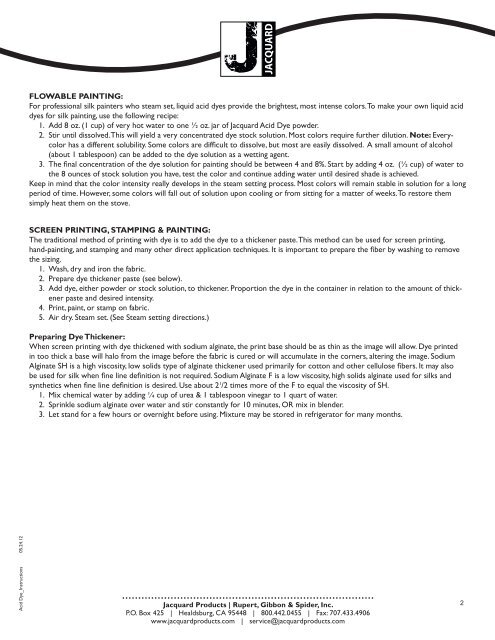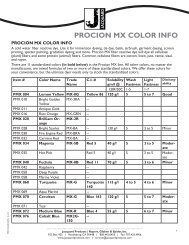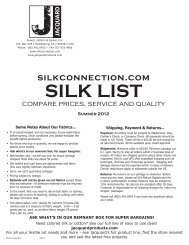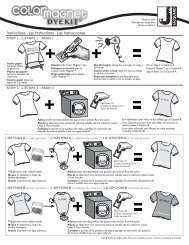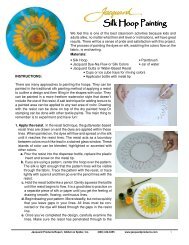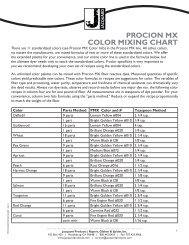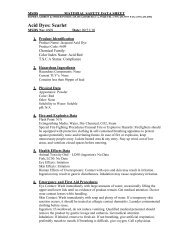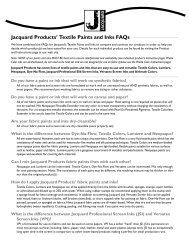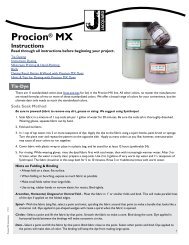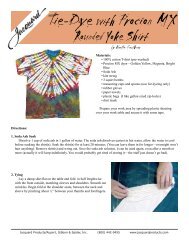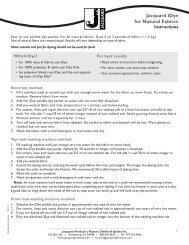Acid Dye Instructions - Jacquard Products
Acid Dye Instructions - Jacquard Products
Acid Dye Instructions - Jacquard Products
You also want an ePaper? Increase the reach of your titles
YUMPU automatically turns print PDFs into web optimized ePapers that Google loves.
FLOWABLE PAINTING:<br />
For professional silk painters who steam set, liquid acid dyes provide the brightest, most intense colors. To make your own liquid acid<br />
dyes for silk painting, use the following recipe:<br />
1. Add 8 oz. (1 cup) of very hot water to one ½ oz. jar of <strong>Jacquard</strong> <strong>Acid</strong> <strong>Dye</strong> powder.<br />
2. Stir until dissolved. This will yield a very concentrated dye stock solution. Most colors require further dilution. Note: Everycolor<br />
has a different solubility. Some colors are difficult to dissolve, but most are easily dissolved. A small amount of alcohol<br />
(about 1 tablespoon) can be added to the dye solution as a wetting agent.<br />
3. The final concentration of the dye solution for painting should be between 4 and 8%. Start by adding 4 oz. (½ cup) of water to<br />
the 8 ounces of stock solution you have, test the color and continue adding water until desired shade is achieved.<br />
Keep in mind that the color intensity really develops in the steam setting process. Most colors will remain stable in solution for a long<br />
period of time. However, some colors will fall out of solution upon cooling or from sitting for a matter of weeks. To restore them<br />
simply heat them on the stove.<br />
SCREEN PRINTING, STAMPING & PAINTING:<br />
The traditional method of printing with dye is to add the dye to a thickener paste. This method can be used for screen printing,<br />
hand-painting, and stamping and many other direct application techniques. It is important to prepare the fiber by washing to remove<br />
the sizing.<br />
1. Wash, dry and iron the fabric.<br />
2. Prepare dye thickener paste (see below).<br />
3. Add dye, either powder or stock solution, to thickener. Proportion the dye in the container in relation to the amount of thickener<br />
paste and desired intensity.<br />
4. Print, paint, or stamp on fabric.<br />
5. Air dry. Steam set. (See Steam setting directions.)<br />
Preparing <strong>Dye</strong> Thickener:<br />
When screen printing with dye thickened with sodium alginate, the print base should be as thin as the image will allow. <strong>Dye</strong> printed<br />
in too thick a base will halo from the image before the fabric is cured or will accumulate in the corners, altering the image. Sodium<br />
Alginate SH is a high viscosity, low solids type of alginate thickener used primarily for cotton and other cellulose fibers. It may also<br />
be used for silk when fine line definition is not required. Sodium Alginate F is a low viscosity, high solids alginate used for silks and<br />
synthetics when fine line definition is desired. Use about 2 1 /2 times more of the F to equal the viscosity of SH.<br />
1. Mix chemical water by adding ¼ cup of urea & 1 tablespoon vinegar to 1 quart of water.<br />
2. Sprinkle sodium alginate over water and stir constantly for 10 minutes, OR mix in blender.<br />
3. Let stand for a few hours or overnight before using. Mixture may be stored in refrigerator for many months.<br />
<strong>Acid</strong> <strong>Dye</strong>_<strong>Instructions</strong> 05.24.12<br />
<strong>Jacquard</strong> <strong>Products</strong> | Rupert, Gibbon & Spider, Inc.<br />
P.O. Box 425 | Healdsburg, CA 95448 | 800.442.0455 | Fax: 707.433.4906<br />
www.jacquardproducts.com | service@jacquardproducts.com<br />
2


